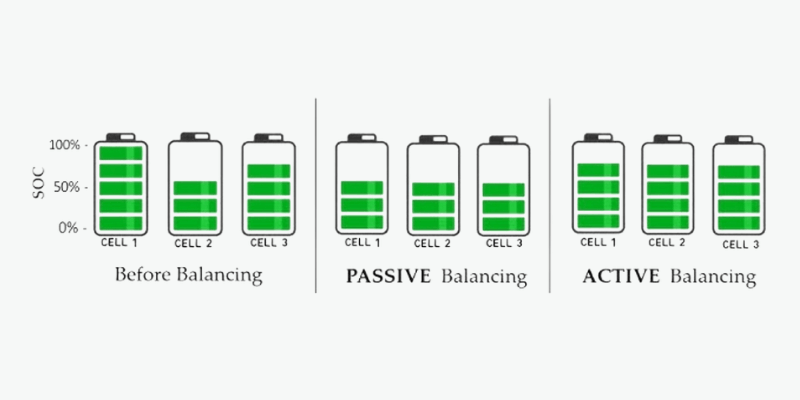Kľúčové poznatky:
- Vyvažovanie buniek LIFEPO4 je nevyhnutné na udržanie špičkového výkonu a bezpečnosti.
- Preskúmajte techniky, rozdiely od batérií SLA a aplikácie v reálnom svete revolúcie v riešeniach energie.
Pred Postavenie batérie, je dôležité zabezpečiť, aby sa všetky bunky LIFEPO4 zhodovali s hodnotením kapacity, napätím a vnútorným odporom. Navyše, vyrovnávanie buniek po výrobe je nevyhnutnosťou.
Tento článok bude slúžiť ako váš sprievodca po pochopení vyrovnávania buniek LifePO4.
Poďme sa ponoriť priamo do!
Pochopenie vyváženia buniek: Čo to je?
Vyvažovanie buniek je koncept, ktorý pochádza z praxe úpravy buniek na základe ich kapacity a napätia. Tento proces zaisťuje, že napätie sa počas cyklistiky batérií riadi, aby sa udržal zostatok alebo dosiahol takmer rovnaké napätie vo všetkých úrovniach nabíjania (SOC).
Je dôležité pochopiť, že vyrovnávanie buniek nie je jednorazovým postupom, ale skôr nepretržitou nevyhnutnosťou pred zostavou batérie aj po zostavovaní batérie, ako aj počas celého životného cyklu batérie, aby sa udržal špičkový výkon.
Tento princíp je podobný metóde, ktorá sa používa pri snahe o harmóniu medzi jednotlivými batériami nakonfigurované v sérii.
Vyvažovanie rozdielov buniek LifePo4 a SLA
Proces vyrovnávania buniek LiFePO4 zahŕňa použitie dosky s obvodmi, ktorá by mohla byť vyváženým obvodom, modulom ochranného obvodu (PCM) alebo systém správy batérie (BMS). Tieto komponenty sú zodpovedné za monitorovanie batérie a jej buniek.
Keď sa batéria blíži k 100% stavu nabíjania (SOC), vyrovnávací obvod vyrovná napätie každej bunky v batérii pomocou hardvéru. Štandardné bunkové napätie pre fosforečnany lítium na rovnováhu je 3,6 voltov.
Naopak, PCM alebo BMS udržiavajú rovnováhu nielen prostredníctvom hardvéru, ale tiež ponúkajú ďalšie ochrany a riadiace schopnosti v rámci svojich obvodov, ktoré chránia batériu nad rámec toho, čo dokáže jednoduchý obvod vyváženia. Zahŕňa to obmedzenie nabíjacieho/vybíjajúceho prúdu batérie.
Batérie zapečatenej olovnatej kyseliny (SLA) sa spravujú inak od lítiových batérií, a preto je ich vyvažovací proces odlišný. Batéria SLA dosahuje rovnováhu tým, že sa nabíja na mierne vyššej úrovni ako normálne úrovne napätia, pretože im chýba vnútorné monitorovacie systémy.
Aby sa zabránilo tepelnému úteku, tieto batérie vyžadujú vonkajšie monitorovanie buď prostredníctvom zariadení, ako sú hydrometre, alebo manuálne jednotlivec v rámci bežných postupov údržby; Toto nie je automatický proces.
Techniky a technológie používané na efektívne vyváženie buniek LIFEPO4
Na vyvažovanie buniek LifePO4 sú použité dve hlavné techniky: aktívne a pasívne vyváženie.
Pasívne vyvažovanie zahŕňa rozptyľovanie nadbytočného náboja z buniek s vyšším napätím do slnkových napäťových buniek prostredníctvom rezistorov alebo skratových obvodov.
Aj keď je táto metóda jednoduchá a nákladovo efektívna, nemusí byť tak účinná ako aktívne vyváženie pri zabezpečovaní rovnomerných hladín náboja vo všetkých bunkách.
Na druhej strane aktívne vyváženie využíva elektronické obvody na aktívnu redistribúciu energie medzi bunkami. Táto technika je presnejšia a môže pomôcť udržať konzistentné napätie buniek, čo vedie k zlepšeniu celkového zdravia batérie.
Advanced BMS zohráva kľúčovú úlohu pri efektívnej implementácii týchto vyrovnávacích techník. BMS môže monitorovať jednotlivé bunkové napätia, teploty a prúdy, aby sa zabezpečilo optimálny výkon, pričom chráni batériu pred nadmerným nabíjaním alebo nadmerným vypúšťaním.
Presvedčivé dôvody vyváženia buniek LifePO4
Ak bunky LifePO4 nie sú vyvážené, môže to viesť k problémom, ako je znížená kapacita, skrátená životnosť a dokonca aj bezpečnostné riziká, ako je prehrievanie alebo požiare.
Vyvažovanie buniek LIFEPO4 zaisťuje, že každá bunka v batérii je rovnomerne nabitá a prepustená. Pomáha to pri optimalizácii celkového výkonu systému batérií a zabraňuje preplneniu alebo nadmernému nablutovaniu akejkoľvek jednotlivej bunky.
Vyvážením buniek LifePO4 v podstate maximalizujete účinnosť a spoľahlivosť batérie. Tento proces pomáha predĺžiť životnosť batérií, zlepšovanie ich schopností ukladania energie a podporu bezpečnej prevádzky.
Aplikácie v reálnom svete: Ako vyrovnávanie buniek LifePO4 revolúcia v riešeniach ukladania energie
Od systémov na skladovanie solárnej energie až po elektrické vozidlá (EV) a prenosné energetické banky, využitie vyvážených bunkových fosfátových buniek lítium železa revolúciou v tom, ako ukladáme a využívame energiu.
V systémoch Solar Energy Storage zabezpečuje vyváženie buniek LifePO4 optimálny výkon a dlhovekosť batérií. Tým, že tieto systémy udržiavajú každú bunku v konzistentnom stave náboja, môžu efektívne uchovávať prebytočnú solárnu energiu na použitie počas období s nízkym slnečným žiarením alebo vysokým dopytom.
Elektrické vozidlá tiež veľmi úžitok z tejto technológie. Bunky LIFEPO4 so správnym vyvážením pomáhajú zlepšiť celkový výkon a rozsah EV a zároveň zaisťujú bezpečnosť tým, že zabránia nadmernému nabíjaniu alebo prehriatiu problémov.
Prenosné energetické banky vybavené vyváženými lítiovými železnými fosfátovými bunkami ponúkajú používateľom spoľahlivý a bezpečný zdroj záložnej energie na cestách. Presné vyváženie buniek v týchto energetických bankách maximalizuje účinnosť a rozširuje ich životnosť, čo používateľom poskytuje trvalé a dlhotrvajúce energetické riešenie.
Začlenením vyrovnávania buniek LiFEPO4 do riešení v oblasti skladovania energie sú priemyselné odvetvia schopné dosiahnuť zvýšený výkon, zlepšené bezpečnostné prvky a zvýšenú spoľahlivosť svojich výrobkov. Táto technológia pripravuje cestu pre udržateľnejšiu a efektívnejšiu budúcnosť v aplikáciách na ukladanie energie.
Záver
Záverom je, že integrácia technológie vyváženia buniek LiFEPO4 je významným krokom k dosiahnutiu trvalo udržateľných energetických riešení a predĺžení životnosti batérií.
Zabezpečením optimálneho výkonu a účinnosti v lítium-iónových batériách sa vyrovnávanie buniek nielen zvyšuje spoľahlivosť systémov na uchovávanie energie, ale tiež prispieva k zníženiu vplyvu na životné prostredie.
Súvisiace články:

